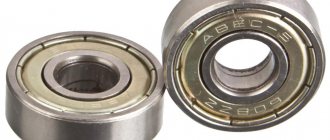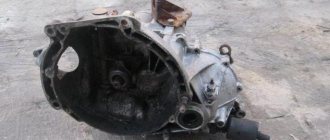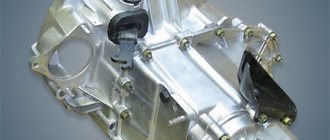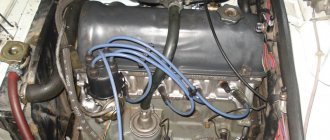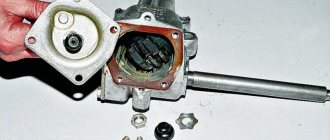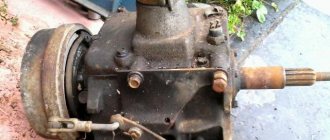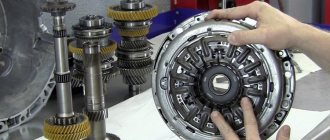Transmission bulkhead
To make repairs and replace parts, you need to know how to disassemble the Gazelle box itself.
Yes, you will have to disassemble it anyway. There is a chain of actions here:
bearing cover – rear input axis (bushing) – breather – crankcase separation – fastening the gear shift fork (after putting the car in reverse mode) – lever body and gasket – clamp fittings – switch rods (order – 1, 2, 5, rear, 3, 4) – reverse axle and remove the rear shaft bearing retainer ring – remove the shafts themselves.
The diagram may seem complicated, but if you look at the box in person, everything will become clear. This is what self-removal or replacement of the Gazelle gearbox looks like.
Installation of the entire system is carried out in reverse order. The main thing is to remember to carefully lay out the removed parts so that you don’t get confused during the reverse process.
The box turns off and the gear falls out
If the speeds are off, the culprit may be the fork, clutch, or worn transmission gears. It happens that the spring that presses the fixation ball bursts. It is also possible that the input shaft splines may dry out. The reason may be the bronze crackers on the third and fourth gear forks - they break in half. It is also possible that burrs may form on the locking device. Many defective parts are installed on the Gazelle gearbox right from the factory. For example, blocking rings, which must have a gap of at least 0.3 mm. In fact, there are many such elements with a gap of 0.1-2.5 mm.
Video instructions for gearbox repair
Gearbox VAZ 2110 5 mortar device diagram
It is more convenient to work together.
We screw the filler and drain plugs into place.
Remove the power unit support.
Remove the reverse light switch.
Remove the speedometer drive.
Remove the coupling with the bearing and the foam rings of the front cover.
Using a 12mm wrench, unscrew the three bolts securing the bearing cover (the bolts are installed on the sealant).
Read more: How to distinguish a forged wheel from a cast one
Remove the cover with gasket.
When installing it later, pay attention to the coincidence of the oil drainage channel in the cover and the hole in the crankcase
Using a screwdriver, we remove the cuff of the input shaft from the cover (when disassembling the gearbox, we replace all cuffs regardless of their condition).
Using a mandrel or a head of suitable diameter, we press in a new cuff.
Using a 13mm wrench, unscrew and remove the bolt securing the reverse gear axis bushing to the front crankcase
Using a thin screwdriver, pry up and remove the retaining ring of the input shaft bearing
Using a 12 key, unscrew and remove the breather.
Using a 12mm wrench, unscrew the ten bolts connecting the front and rear crankcases (the two bolts passing through the mounting sleeves are longer than the others).
11
Carefully tapping with a hammer through a brass mandrel, uncouple the front and rear crankcases
In this case, you must not strike the end of the input shaft, as the synchronizers will be damaged.
We disconnect the gearbox housings
Carefully, trying not to damage, remove the sealing gasket
We remove the adjusting shims from the bore under the intermediate shaft bearing in the front crankcase (they may not be there).
In this case, the axial clearance in the bearings is established only by the inter-crankcase sealing gasket.
In 2013 Russia saw the new Gazelle Next. The developers of this model focused on the car's cabin. Everything for the comfort of the driver and passengers. But it was not taken into account that cars such as Gazelle Next drive long distances. And for this you need not only comfort in the cabin, comfortable seats, but also order under the hood of the car. The factory installed a 5-speed Gazelle Next gearbox. The new manual transmission has an assembly with parts from different manufacturers. When passing 40 thousand, switching speed from 2 to 3 or from 4 to 5, the driver begins to hear noise, crackling and other strange sounds. To determine what kind of sound it is, you need to have at least a superficial idea of what it is?
This is what Gazelle-Next looks like
Gazelle and Volga gearboxes: a simple and reliable transmission basis
The Gorky Auto and Volga cars use the same transmission design and identical components, including a unified range of gearboxes. Read about the most common GAZ gearboxes, their design, characteristics, features and maintenance nuances in this material.
A general look at the transmission of GAZelle and Volga vehicles
GAZ passenger cars and light-duty trucks (“GAZelle”, “Sobol” and “Volga”) have the same transmission design and unified in many components. Currently, two types of cars are produced (or were produced, if we talk about the Volga):
- Rear-wheel drive cars with a 4x2 wheel arrangement - these are all Volga cars and most GAZelle and Sobol models; — All-wheel drive vehicles with a 4x4 wheel arrangement — the new GAZelle model range of models 27057, 32217, 322174, 33027 and 330273, as well as Sobol models 22177, 221717, 23107 and 27527.
The transmission of rear-wheel drive vehicles is traditional; it includes a dry friction single-plate clutch, a 4- or 5-speed (depending on the model and year of manufacture of the car) manually controlled gearbox, a composite or solid (in a number of new GAZelle trucks) driveshaft and a drive axle of a rigid structure (banjo type, with a supporting beam), which houses the main gear, differential and axle shafts.
The transmission of GAZ 4×4 vehicles is complemented by a transfer gearbox, which, unlike a number of other trucks, is located separately from the main gearbox - the transfer case is installed almost in the center of the frame, and torque is transmitted to it from the gearbox by a separate driveshaft. Two cardan shafts come from the transfer case - to the front and rear drive axles. Control of the transfer case (engaging front-wheel drive) is manual, using levers located in the cab.
The key role in the transmission is played by the gearbox, which should be discussed in more detail.
Types, differences and applicability of GAZ gearboxes
The GAZelle, Volga and Sobol vehicles use a unified model range of gearboxes, which are built on a common component base and therefore have the following common features:
The differences between the boxes are minor; they are aimed at harmonizing different types of power units and transmissions. The boxes differ in the following details:
Thus, using only a small number of different parts, you can get a larger number of gearbox models to solve a wide range of problems:
All replacement parts are specially marked:
Input shaft Intermediate shaft gear 1st gear Speedometer drive pair
| GAZelle gearbox, petrol | Annular projection 5 mm wide and 2 mm high on the neck | Circular groove along the radius on the outer cone | 4 holes with a diameter of 6 mm along a radius of 40 mm | Marking 3302 |
| Gearbox "GAZelle", diesel | Extended by 48 mm | |||
| Checkpoint "Volga", petrol | Smooth neck | There is no groove | 2 holes with a diameter of 6 mm along a radius of 40 mm | Marking 24 |
| Volga checkpoint, electronic panel | Marking 3110 | |||
| Gearbox "Volga", diesel | Marking 31104 | |||
| Checkpoint "Sobol" | Marking 4.55 |
It should also be noted that early Volg models were equipped with 4-speed gearboxes (and some models existed in versions with old 4-speed gearboxes and with new 5-speed gearboxes), but we will not consider them here.
Structure and design features of the GAZelle and Volga gearbox
Structurally, GAZ 5-speed gearboxes have a simple design. They are based on a lightweight split crankcase, divided in a vertical plane, assembled from the front part (often called simply the crankcase) and the tail. The crankcases are assembled with bolts through a gasket; to ensure accurate installation of the shafts, the crankcase halves are assembled through mounting sleeves.
There are three shafts in the crankcase (they lie in beds, the ends are secured with radial bearings) - primary, intermediate (also called a gear block) and secondary. At the top of the box there is a gear selection mechanism; the lever is placed in a separate housing, which is mounted on four bolts on the shank. It is interesting to note that the lever is equipped with a damper, which prevents shaking and rattling at high speeds.
The input shaft in this box is made quite long, in the front part there are splines cut for connection to the clutch driven disc, and in the rear part there is a gear. The intermediate shaft consists of the shaft itself and gears pressed onto it, with the exception of the 1st gear gear - its teeth are made directly on the shaft. All gearbox gears are helical.
The most complex is the secondary shaft; the gears on it are mounted through needle bearings; between the gears there are inertial synchronizers (three in number), moved by the forks of the gear selection mechanism. The speedometer drive gear is also located on the same shaft. The secondary shaft exits through a shank and is splined to connect to the sliding yoke of the propeller shaft. The shaft in the shank is placed in a steel-babbit sleeve and sealed with cuffs.
The crankcase has two filler plugs (on the top sides) and one drain plug (installed in the bottom part), and a magnet is provided in the drain plug. The shank also contains a fitting for connecting the cable to the speedometer or installing a speedometer sensor. And a breather is installed in the upper part of the front crankcase to relieve excess pressure.
In general, the GAZelle and Volg gearbox has a completely traditional design, which is quite simple and reliable.
Maintenance questions for GAZ gearboxes
Servicing the gearbox of GAZ vehicles comes down to the following work:
Particular attention should be paid to changing the oil. In the type of boxes under consideration, transmission oil with a viscosity of SAE 75W-90 or 85W-90 (depending on climatic conditions) is filled in an amount of only 1.2 liters. The oil is drained immediately after stopping the engine; if the oil is excessively contaminated, it is recommended to additionally rinse the box (you can use a different oil).
During maintenance, the general condition of the gearbox is also checked, and if faults are detected, repairs are carried out. It should be remembered that the primary and intermediate shafts of the boxes can only be replaced as an assembly, and the secondary shaft can be repaired by replacing individual gears or bearings. Any damage to the crankcase requires its complete replacement.
With regular maintenance, the use of recommended oils and high-quality spare parts, all gearboxes of Volga, GAZelle and Sobol cars will reliably perform their functions for many years.
Source
Features of the GAZelle gearbox: design and repair
Gazelle business wiring diagram
The gearbox is a component of the transmission. It changes the gear ratio and torque transmitted from the engine to the vehicle's drive wheels. The gearbox has a very impressive service life and is capable of functioning flawlessly throughout the entire life of the vehicle. But this requires timely and high-quality checkpoint maintenance.
Today we will disassemble the gearbox of a Gazelle car. Let's add oil. To do this you will need a 12mm hexagon. If chips are found on the plug, it means there is wear in the gearbox.
The manufacturer recommends filling 1.2 liters. oil into the gearbox, but we recommend pouring at least 1.5 liters to avoid “oil starvation” in fifth gear during overload.
We disassemble the gearbox. For convenience, clamp it in a vice with the shank down, at an angle.
We unscrew all the bolts with a 12 mm socket, starting from the front flange and the input shaft, then the gearshift lever cover. It is more convenient to unscrew the bolts connecting the box body using a head with a “cardan”.
Using a 13mm socket, unscrew the bolts securing the reverse gear.
Remove the input shaft flange and clean off the remaining gasket and sealant on the housing.
Next, you need to remove the retaining ring, otherwise you will not be able to halve the box.
Remove the top half of the housing.
Unscrew the forks. Use pliers to remove the gear shift rod.
Be careful, the bearings may fall out. The outer rods are removed first, then the central one. It has an additional fixation rod.
If the rod is worn out, only the working part must be replaced. It is not advisable to completely change the stem.
We remove the forks and check the wear of the “crackers” - if they are good, we leave them.
The following operation must be carried out with an assistant. Use a pair of narrow-nose pliers to press the stopper and hold it, lifting the gear block until it disengages from the clutch.
We take out the gear block and begin an inspection; if chips are found on the gears, they need to be replaced.
When disassembling the “box”, we recommend replacing the input shaft seals and shank seals.
Remove the input shaft. Inside the shaft there are 14 rollers that spin on the shaft. To replace the bearing, you must remove the retaining ring.
Since the bearing is seated on the shaft, it must be knocked out. All other transmissions are analyzed by analogy. The retaining ring is removed, the gears are removed, and an inspection is carried out for chips.
After completion of the repair, assembly is carried out in the reverse order.
Source
Gazelle gearbox repair, diagnostics, replacement of gearbox bearings
Automatic transmission for GAZelle Next
Recently, many GAZelle Next car holders are installing imported parts on their car, as they show their best side, functionality and performance are much better than factory parts. With the installation of the Toyota power unit, an automatic gearbox is also installed. A lot of drivers, complaining about traffic jams in the city, dream of such an opportunity. Automatic transmission offers many advantages.
Interior view of Gazelle Next automatic transmission
- Safe management.
- There is no need to work with your right hand (shifting gears) and left foot (clutch) every time.
- Traffic safety.
- Smooth and soft control.
- Reduced engine wear.
- Good cross-country ability of the car on dirt roads, as well as on snowy or muddy roads.
Despite such bright positive aspects of automatic transmission, there are disadvantages:
- Fuel consumption increases.
- The maximum speed will be reduced.
- In case of emergency driving (skidding in winter), the automatic transmission will not help.
- The oil needs to be changed more often than with a manual transmission.
- Expensive repairs.
- Low load capacity.
And one more drawback. According to car enthusiasts, if a loaded Gazelle Next travels long distances, the service of the automatic transmission will be limited to a year of operation.
Features of gearbox repair
Connection diagram for engine sensors gazelle 406 carburetor
Do not think that repairing a Gazelle gearbox with your own hands is easy. The gearbox is a complex mechanism that transmits torque from the engine shaft to the drive wheels. Your safety depends on it and the slightest deviations in the operation of the gearbox signal the need for diagnostics. You shouldn’t be afraid of difficulties - after all, there may not be a service station nearby, and step-by-step instructions will help even a novice car enthusiast to successfully cope with the matter.
Features of Gazelle gearbox repair
The Gazelle gearbox is reliable and durable. But constant loads sometimes lead to its breakdown. Gazelle gearbox repair will require the driver to:
- knowledge of vehicle hardware;
- the ability to remove the gearbox, disassemble it, and then reassemble it and put it in place;
- strict adherence to safety regulations;
- attention, accuracy and patience.
Important! You should not repair the gearbox alone - you need a partner
How does the gearbox work on a Gazelle?
The gearbox is manual, five-speed. Comprises:
- two aluminum crankcases (connected with 10 bolts);
- primary and secondary shafts (connected to the crankshaft and cardan);
- an intermediate shaft with cut teeth for 1st gear and reverse gear, a pressed-on gear block and a speedometer drive gear;
- inertial synchronizers;
- spring-loaded balls for fixing gears;
- locking gears at the same time;
- lever damper device;
The Gazelle gearbox design allows you to respond to the first symptoms in time to prevent more severe consequences.
When is transmission repair necessary?
The signal for urgent repair of the Gazelle gearbox is:
- Inability to change gear or if it is difficult to do so.
- When trying to change gear while driving, a loud cracking sound is heard.
- Shifting gears on your own (risks an accident).
- Any extraneous noise, crunching, knocking in the gearbox.
- Routine diagnostics of the Gazelle's gearbox must be carried out every 300,000 km.
Main gearbox malfunctions on GAZ 3307 vehicles
Long-term operation of Gazelle cars has made it possible to compile a list of the main malfunctions of the Gazelle gearbox and their possible causes:
- The cause of the humming noise during operation is the destruction of worn parts or loosening of the fastening bolts;
- Crunching in the gearbox - destruction of bearings;
- Crackling sound when switching - synchronizer rings are worn out;
- Difficulty shifting gears - jamming in the gearbox drive, wear of gears, burrs, etc. (needs to be disassembled and inspected);
- Self-switching off speeds - misalignment of gear teeth, wear of rods and forks, loosening of the gearbox and driven shaft fastenings;
- Oil loss - crack in the crankcases, loose fasteners, wear of the gasket, oil seal, etc.
Important! The causes of some malfunctions (noise, difficult shifting, self-disengaging gears, etc.) may be clutch problems (incorrect adjustment, premature release of the pedal, etc.)
Necessary tool for removing and disassembling the box
For repairs you will need an inspection hole or overpass, as well as tools:
- a set of keys (for 10, 12, 13, 14, 17, 19);
- Screwdriver Set;
- beard;
- wooden blocks;
- pliers (pliers);
- mount;
- pullers;
- hammer;
- needle file, sandpaper;
- brass pad or copper hammer;
- mandrel for old oil seals.
- container for draining oil;
- rags;
- CV joint-4, transmission oil, GOI paste.
How the box works
GAZelles are equipped with 4- or 5-speed manual transmissions. Components of the device:
- 2 aluminum crankcases connected by 100 bolts;
- speedometer drive gear;
- primary and secondary shafts connected to the cardan and crankshaft;
- an intermediate shaft on which the cut reverse and 1st stage teeth are located;
- pressed gear block;
- inertial synchronizers;
- reverse gear is provided by a gear block;
- clutch for engaging 3rd and 4th gears;
- system for blocking simultaneous launch of several speeds;
- spring-loaded balls for fastening different levels of the box;
- mechanism of the damper device of the lever and control elements.
The design of the unit allows for timely diagnosis of the first signs of malfunction to prevent more dangerous failures.
Specifications
Key characteristics of the gearbox of GAZelle cars:
- 4- or 5-speed transmission;
- 5 speeds - 1 reverse and 4 forward.
For the transmission, the following parameters can be noted:
- three-way lever located in the assembly;
- the mass of the part is 56 kg;
- oil tank capacity - 3 l;
- gear ratios for five stages - 6.55; 3.09; 1.71; 1; 7.77.
- The fourth stage in the gearbox is direct.
Basic models of the device assume the presence of synchronizers in the mechanism to ensure reliable operation.
Gear shift diagram
The gear scheme on the GAZelle is distinguished by the presence of a synchronizer. Moving the lever from the neutral position to the left side causes its lower part to move the shift rod and fork. This causes the first stage gear to move backward and come into contact with the first gear element located on the intermediate shaft. When the clutch is running, torque is transmitted through gears and intermediate elements to the secondary shaft.
The inclusion of the third speed is due to the movement of the lever from the neutral position, first to the right side, and then forward. Under the influence of the fork, the clutch begins to move backwards and the structure impacts the synchronizer. The torque follows in the direction of: the input shaft, the permanently meshed gears, the intermediate and secondary shaft of the gearbox.
To start the fourth speed, you will need to move the selector to the right and back relative to neutral. The forward movement of the clutch helps to engage the synchronizer locking ring with the input shaft. After balancing the speeds, gears are engaged. Reverse speed is started by moving the lever to the right after overcoming the resistance of the safety system.
The synchronizer is a mechanism in the form of a hub mounted on the secondary shaft of the box. The coupling moves along the splines located outside under the influence of the fork. Other key elements of the synchronizer:
- retaining springs;
- "blocking" parts;
- side bronze rings for locking the mechanism;
The work of the synchronizer is involved in engaging 3rd and 4th gears and is expressed in ensuring a smooth transition from one level to another.
How much oil to fill
Before changing the oil in the 5th mortar, it is necessary to check the current level. It is recommended to carry out such an action every 20,000 km. If there is enough oil in the gearbox, fluid is added to the crankcase.
The technical documentation does not contain data on the required amount of oil in the GAZelle box. The figure varies depending on the modification of the equipment, ranging from 1.2-1.6 liters. During work, the mixture is poured into the hole with a syringe until oil flows out of it.
GAZelle Next, GAZelle Business and other modifications of the car cannot be started with a low level of oil fluid. Small volume is the cause of air pockets, which have a negative impact on bearings and other elements of the gearbox.
Possible malfunctions during operation of the transfer case
Transfer case malfunctions are similar to problems with a conventional transmission. Among them are:
- breakage or chipping of gear teeth;
- gear shifting spontaneously;
- Noise is noticed when the gears operate;
- 2 gears are switched on simultaneously;
- Gears are difficult to engage.
Oil leaks from the transfer case due to damage to the sealing gasket or wear of the seals. A crack in the housing may also be the cause.
Gear noise when shifting gears occurs when the clutch breaks down or is not adjusted correctly. It is necessary to replace the failed part. But noise when the Gazelle moves may indicate poor lubrication of parts or wear of bearings.
Knowing these and other faults, you can easily prevent more complex breakdowns of your car. We hope that these simple features of operating the Gazelle transfer case will be useful to you!
Diagram of the GAZ-53 gearbox
Here we will talk about the gearbox of the famous GAZ 53 truck.
Design and diagram of a gearbox from a GAZ 53 truck.
The gearbox on this truck has four forward speeds and one reverse. It is mechanical, consisting of three shafts: drive, driven, intermediate. The GAZ 53 gearbox is designed for three strokes.
Thanks to the gearbox, it is possible to transfer the speed that the engine develops to the drive wheels, while changing the amount of traction force. If necessary, using the gearbox, you can stop transmitting these revolutions to the drive wheels. This corresponds to the neutral position of the gear lever.
Positions of the GAZ-53A gearbox shift lever.
Possible problems with the Gazelle gearbox
Disassembling and repairing a gearbox (5-speed), regardless of the make and model of a Gazelle car, is always a crucial moment, anticipating serious work. Owners of commercial vehicles encounter this problem most often, so they have replaced it more than once. But is it worth it, having seen an advertisement on the Internet for repair of a Gazelle gearbox, to run there, jingling your wallet? Not necessary. It is quite possible to get by with an assistant, diagrams of the gearbox design and instructions for the necessary work. This is enough to repair or replace worn parts yourself.
The presence of a huge experience base on problems with the Gazelle box allows you to almost accurately draw up a “problem-cause” diagram.
Most often, the problem list looks like this:
- If during operation you hear a dull hum from the side of the box, this is a sure symptom of loosening of the fixing fasteners. Also, such a sound can signal the death of the most worn parts;
- The characteristic “crunching” sound is most often produced by worn-out bearings. In general, to avoid such a problem, it is recommended to replace bearings after 90 - 100 thousand km. On your own, or as planned at a service – it’s up to you to decide what’s convenient for you
- If gear shifting is accompanied by an unpleasant crackling noise, then it makes sense to think about replacing the synchronizer rings;
- There can be many reasons for difficult gear shifting. Perhaps the box drive itself is jammed or jammed. But there may also be wear of a certain group of parts (gears, burrs, etc.). Only a bulkhead will tell you the exact reason.
- Oil leak. According to statistics, this is the most common problem that is addressed to workshops. As in the case of oil loss in the engine, the main culprit here is hardened or, on the contrary, worn out gaskets and seals. But it may turn out that much more serious cracks in the crankcases are to blame.
It may turn out that the indirect cause of the problems described above is incorrect clutch adjustment. Or simply working with it incorrectly. For example, a constant change of minibus drivers and their different qualifications can damage the gearbox up to the “fifth gear”.
Bulkhead of the five-speed Gazelle/Volga gearbox. Part 1 - Disassembly and troubleshooting.
All screws can be easily unscrewed with a ratchet after breaking. Halve strictly with blows to the body. If you hit the input shaft, the impact energy will be transmitted exactly through the 4th gear synchronizer. Place all the parts in piles. If you have symptoms of hand-wringing, it would be a good idea to take pictures of the parts before disassembling. So, let's start troubleshooting. When examining the rear oil seals, a bald spot on the second oil seal was revealed. I installed them 5 years ago:
The bushing will be discussed in more detail in the next part:
From my findings, to check wear, you can use the gearbox flange on which the release bearing runs - its diameter is exactly 38 mm, like that of the cardan fork. In my mind there should be no backlash:
Next, remove the bearings from the shaft. They are pryed off with screwdrivers and removed without problems:
By the way, I ended up with a box with tapered bearings, bronze nuts and new type synchronizers. Formally, there was no fatal wear on the tapered bearing races (also known as the hub bearings of the front wheels), meaning shells, but the rollers were polished on the inside of the bearing:
Thus, they were worn out so much and went deep that their ends rested against the inner race. It clearly shouldn't be this way. Interestingly, the rollers themselves are also conical (10-9.3 mm).
The crackers had fairly little wear:
Due to the use of high-quality semi-synthetic Rosneft GL-4, the inside of the box was washed perfectly with dishwashing detergent:
The breather channel was clean:
There were no signs of rotation in the bearing seats. The bearings themselves are easy to remove and insert with a slight rotation:
I removed the barrels for blocking the engagement of two gears at the same time with a magnet, since I washed the body with water and otherwise they could rust:
An overflow hole was found in the rear half of the gearbox. Thanks to it, the trick of filling the gearbox oil through the handle from the passenger compartment is possible:
I think its purpose is to equalize air pressure, since the cardan shank works like a piston pump and without damping fluctuations in air pressure by the main volume of the gearbox, the box would suck in dirt from the street:
It was not possible to knock down the main shaft bearings with a screwdriver and hammer. I used a regular two-legged puller, lengthening its legs with thick steel plates. There are special pullers for these purposes, but I didn’t use them; it’s a very rare task and can be completely solved with a two-legged puller. On the input shaft I was pleased with the oil channel going under the bearing. What's so funny, I don't understand:
I did not find any wear on the shaft articulation unit, but the rollers had barrel-shaped wear - they were down by one hundred square meters in the center, and by 5 at the edges. The clips themselves were without damage, and measurements with a caliper showed the tolerance:
The part of the shaft entering the crankshaft also had no noticeable wear:
The shift clutches were worn out by several tenths of a mm: The outer splines of the clutch hubs, although they were polished to a shine, did not have any noticeable play:
But the clutch hub of the 1st and 2nd gears had a slight play on the secondary shaft and was replaced:
Visually there were noticeable dents on it:
ᐈ Gazelle gearbox repair Kyiv - Prices 2022, Cost of Services
The All-Ukrainian TV channel in the program “Breakfast with 1+1” interviewed Roman Kirigetov, the founder of the Kabanchik.ua project, live about how the service works and how to safely order the services of private specialists in Ukraine.
Professional automatic transmission repair in Kyiv is a complex repair service that is in demand among many car owners. The most common cause of automatic transmission streaking is improper operation. To find and eliminate the cause of failure, specialized equipment and professional experience from a master are required. You can choose a specialist with in-depth knowledge to carry out repair work using the Kabanchik service.
When is gearbox repair needed?
Of course, the easiest way is to use the gearbox correctly and avoid breakdowns. To do this, it is enough to avoid a sharp increase in speed, when driving on sand, wet and snow-covered asphalt, to avoid slipping, and not to exceed speeds above 150 km/h (or, alternatively, change the oil in the gearbox more often). But if the conditions cannot be met, the gearbox will need to be repaired - the signs of its relevance are as follows:
- the oil has become black or dark brown;
- there is a sharp burning smell;
- there is noise in the automatic transmission;
- the car drives jerkily;
- oil leaks out.
Any of these signs is quite serious, so you need to contact a specialist immediately. What is the repair process? This is a restoration of functions according to factory transmission requirements. Given the complexity of the unit, only experienced craftsmen with specialized equipment for diagnostics and repair work should be allowed to work.
Features of automatic transmission repair
The transmission is the key element of the car. Modern models feature an electronic transmission control system instead of the outdated hydraulic one. Therefore, the qualifications of the master must be appropriate. Types of services for automatic transmission restoration:
- Automatic transmission diagnostics and repair. During the process, it is possible to conduct a test visit with a technician and use computer diagnostic tools to identify hidden breakdowns.
- Opening the pallet. This is necessary to analyze the condition of the oil and search for worn components and materials.
- Troubleshooting. Compiling a list of detected breakdowns and methods for eliminating them.
- Repair of gearbox valve body and other components. If possible, the technician will carry out the work without removing the transmission.
The repair can be partial (it is carried out without removal), or major (it is assumed that key elements are replaced). Also, if necessary, the technician will completely replace the transmission with a new one with similar characteristics.
Who can I order gearbox repairs from?
Gearbox repairs and maintenance are complex tasks. However, all car owners are interested in optimizing the cost of a technician’s services, but without sacrificing quality. This is possible if you entrust the work to private, proven contractors who work without any extra charges. Our service will help you find such a specialist or a small team.
Cost of repair of automatic transmission and manual transmission Price, UAH.
| Automatic transmission repair (removed) | from 3500 UAH. |
| Repair of automatic transmission four-wheel drive 4X4 (removed) | from 3700 UAH |
| Manual transmission repair (removed) | from 3000 UAH |
| Defective automatic transmission (without repair) | from 700 UAH |
| Defective CVT gearbox (without repair) | from 800 UAH |
| Troubleshooting manual transmission/transfer case (without repair) | from 450 UAH |
| Removing automatic transmission front-wheel drive | from 1500 UAH |
| Removing automatic transmission four-wheel drive | from 1600 UAH. |
| Removing the CVT gearbox | from 1550 UAH. |
| Removing the manual transmission | from 1100 UAH |
| Installation of front-wheel drive automatic transmission | from 1500 UAH |
| Installation of automatic transmission four-wheel drive | from 1500 UAH |
| CVT Transmission Installation | from 1300 UAH |
| Manual transmission installation | from 1100 UAH |
| Automatic transmission repair with removal and installation | from 4100 UAH |
| Automatic transmission repair with removal and installation of 4X4 all-wheel drive | from 4500 UAH. |
| Repair of CVT gearbox with removal and installation | from 5500 UAH. |
| Manual transmission repair with removal and installation | from 4500 UAH. |
| Computer diagnostics (without automatic transmission repair) | from 150 UAH |
| Changing the automatic transmission oil | from 300 UAH |
| Replacing the automatic transmission axle shaft seal | from 400 UAH |
| Solenoid/Valve Block Replacement | from 950 UAH |
You only need to complete the task - indicate the conditions, offer a price and the optimal completion time for you. Just 5 minutes is enough to select a specialist: from several candidates, with the help of reviews, ratings and portfolios, you can select the best specialist. All performers on the site are verified - this guarantees the safety of the work performed, along with an affordable cost and high quality.
How to repair a Gazelle gearbox
23.10.2017
Gazelle gearbox repair is a complex undertaking that needs to be prepared for in advance. The gearbox operates by transmitting torque to the wheels from the motor shaft. It is worth understanding that the slightest malfunction in the functioning of the transfer case can threaten your safety. If there is no service station nearby, you can repair the fault yourself. If you strictly follow the step-by-step instructions, even a novice motorist can carry out this procedure without any problems.
What are the faults of the Gazelle gearbox?
Gazelle gearboxes are rightfully considered one of the most reliable and durable, but even they can become unusable due to high loads. In order for the replacement of the Gazelle gearbox to go without a hitch, you must know the hardware of the car, study the diagrams, be careful and patient, and also follow the safety rules and understand the principle of operation of the Gazelle 4x4 gearbox.
Gazelle repair may be required in some cases:
difficulty changing gears. This snag occurs due to the lack of fluid in the cylinder or due to the presence of air in the hydraulic drive. In addition, you can check the locking bolts, which often need additional tightening, as well as the transmission intermediate shaft. You can observe how the device jerks in neutral, and the transmission howls. Another sign is that in 4th gear, fifth or second, the device makes a howl, a lot of noise;
The gearbox engages with noise and crackling noise when starting. In this case, the synchronizer blocking ring on the transfer case could be worn out or deformed. Also check the power take-off. It is advisable to replace the blocking ring or power take-off box, and to ensure that the new element fits in without problems, use lapping paste. In addition, check the condition of the input shaft, how the mortar works, whether the car is noisy in neutral;
random shutdown of manual transmission
If you notice such a problem, first of all check the fastening nuts to the clutch housing, as well as the condition of the gazelle gearbox linkage. In addition, the couplings could wear out (worn out teeth), as well as the locking springs (they can either wear out or weaken)
You may also need to adjust the intermediate shaft and input shaft;
the appearance of extraneous noise. In order to get rid of them, it is necessary to replace bearings or damaged gears, add oil to the crankcase or check its alignment with the crankshaft.
To repair a Gazelle gearbox, you must know everything about the structure of the transfer case, because disassembling the gearbox is not an easy task. This is also necessary to determine the type of failure. The most popular reason for Gazelle owners to replace the gearbox is oil leakage. It occurs due to worn out seals or bushings, worn out gaskets, as well as poor sealing of the plugs. In this case, you will need to add or change the oil in your car, as well as replace the bushing.
How to replace a gearbox on a Gazelle
How to remove the box? Replacement of the gearbox is carried out on an overpass or inspection pit. First, drain the oil from the crankcase. Now we remove the cardan. To do this, arm yourself with a file and put a notch on the connecting unit and the continuation of the gearbox on the gazelle. Now remove the support fasteners using keys thirteen and twelve.
Using keys seventeen and fourteen, remove the fixation of the cardan to the flange of the main gear gear. We remove the shank and insert a rag into the hole. Now we need to get the lever to install the gearbox.
To do this, we get rid of the cover and the top of the lever inside the cabin, unclench the bushing, remove the rubber cushion, floor seal and cover, cap and the lever itself.
Device diagrams:
1 2 3 4
Next, disconnect the speedometer from the transmission along with the rear light switch. Now you can remove the transfer case. How to disassemble the gearbox housing? To do this, get rid of the fixation of the exhaust pipes and bracket, disconnect the transmission from the clutch housing, and create protection from a wooden block for the cylinder head. We proceed to removing the transverse fixation of the transfer case and remove the device. Be careful as its weight can reach 30 kg. Install a new element. Be careful not to damage or miss the stepped transfer case.
Other gearboxes for GAZelle NEXT
Some Gazelle owners don’t want to bother with the “native” gearbox. Then the search for an alternative begins. If you take gearboxes like those from Ford, then you need to work hard with them to “fit” the box to Gazelle standards.
Manual gearbox from Getrag, made in Germany. This box is made for cars with a load capacity of 2400 kg, so it can easily work on the Gazelle Next. Torque 345 Nm. for a 150 l/s engine. The Gazelle's factory gearbox is made of aluminum, the Getrag gearbox is cast iron. It also has some characteristics that make the engine easier to operate during acceleration, and also reduces engine speed on the highway.
This is what the Getrag checkpoint looks like
The table provides comparative data.
News
After a long illness, on June 19, 2022, master Andrei Vladimirovich died at the age of 59. He was an exemplary family man, a good father and grandfather, a master from God, a real man. We all remember him and mourn him immensely. This site will continue to operate, but it is unlikely to be updated. 04/28/12 New version of our free program for GSK - AVgarage
! 12.11.10 Replacing the rear silent blocks of the lower arm of the front suspension on MMC Lancer IX in pictures. 25.11.09 We kindly ask customers to pick up spare parts forgotten at the service within 2 weeks. 02/12/08 Replacing the camshaft oil seal on the MMC Space Runner (4G93 engine) in 5 minutes. 02/05/08 The master installs a VAZ gearbox on IZH “Oda” cars with a Zhiguli engine. 01/25/08 Repairing a gearbox and replacing a clutch on a Mitsubishi Space Runner in pictures. 01/14/08 From now on the site will live at this address. 01/30/07 Material has been added about the design and installation of the secondary shaft of the gearbox of rear- and all-wheel drive VAZs of the new model. 01/20/07 Work on a new version of the site has been completed. 08/12/05 New pages have appeared - Useful and Cooperation. 06/21/05 The Conference is open on the website. 03/19/05 A section on repairing the transfer case of all-wheel drive VAZs has been added. 03.13.05 Information has appeared about the design and malfunctions of the transmission of all-wheel drive VAZs. 02.12.04 Photos of faulty units and parts of gearboxes with comments from the foreman have appeared. 11/23/04 Photos of faulty components and parts of the gearboxes of rear-wheel drive VAZs with comments from the technician have appeared. 06.21.03 The content of the paragraph devoted to the conversion of the 4-speed VAZ gearbox into a 5-speed one has been changed.
Selecting transmission oil for manual transmission
SAE 75W-90
Regular transmission inspections ensure safe and comfortable driving. The main factor in maintaining the transmission system in good condition is the use of high-quality oil.
For GAZelle, it is recommended to use gear oil with a viscosity of SAE 75W-90. It provides reliable protection against gearbox wear and corrosion and has good fluidity at low temperatures.
Changing the transmission oil can be done by yourself; it is prescribed at 60,000 km. However, it is possible to carry out this procedure earlier, for example, if you often travel cross-country.
Thus, the GAZelle model 3302 should not be overloaded. A properly functioning gearbox will ensure the normal operation of other vehicle systems. The main reason for expensive mechanical repairs is the driver’s neglect of regular maintenance. Malfunctions with the gearbox also occur due to the fact that low-quality fuel was used. The entire transmission system suffers from this. The problem can be avoided if you constantly monitor the fluid level in the GAZelle 3302 gearbox.
GAZ Gazelle 3302 “Kostya old man” › Logbook › Gearbox repair
Having installed new wheels, we began to deal with the second big problem, namely, difficult gear shifting; upshifting occurred normally, but downshifting was difficult. I suggested to Kostya that he sort through the box himself; first of all, there is no need to pay the service, because... There are big problems with money, then of course I wanted to do it well, but the service department does it too quickly, 4-5 hours for everything, removal, repair and installation, and of course I really enjoyed it myself))). But Kostya was a little freaked out, he still didn’t know me well, and didn’t quite believe that this could be done by the two of us, but he agreed, he liked cost calculations and he also wants to learn how to do independent repairs. First of all, I want to say a big thank you to my father, at my request, he agreed at work to put the car in a pit for the weekend, which we really needed, and his work is located not far from our garages. And so on Friday evening we put the Gazelle in the pit, and while Kostya was driving from work to the garage, my father helped me remove the box and take it to the garage, and there was heat and all the tools. So, Kostya had almost arrived, and while he was still driving, I managed to drain the oil.
It looks like the oil hasn't been changed since the previous gearbox repair.
And so Kostya and I, in a few hours, disassembled and defected all the parts of the box, so that the next morning we could go to the store and buy everything we needed.
This is me, in the process of disassembling the secondary shaft
We bought everything we needed.
Two new forks with nuts, two rings for the couplings, one synchronizer, three bearings and all seals with gaskets (parts missing in the photo)
The washing up
Kostya single-handedly washed all the parts of the gearbox first in gasoline, then a second time in a wax and, of course, the body too. At that time I was doing something else with the car, which I will write a separate blog about later, so as not to mix everything up.
I don’t know how others rearrange the rings on the couplings, I just heard a complete reassembly...
I did it in 2 seconds, squeezed out the inside a little, placed a new ring in alignment and squeezed out all the insides into it.
And here it is assembled, so to speak, a new secondary shaft.
We didn’t have time to take any more photos, because... It was already late and we really wanted to go home. Both bearings on the intermediate shaft were replaced. One came off quite easily, but the second one had to be tinkered with. It was impossible for the puller to catch on to it, and I couldn’t think of anything else how to block the bearing and carefully cut it off with a grinder.
Everything was assembled into a housing, with new seals, with new gaskets, everything was sealed, the reverse sensor was also sealed.
We installed the gearbox back on the car and filled in new oil.
The rocker lever was covered in burrs...
I think it shouldn't be like this...
I carefully polished off all the burrs, generously lubricated everything with saltedol and installed it in place.
The gearshift lever ran all over the cabin, did not hold on at all, it could be removed while driving, hit the passenger, and put back in))). It was customary to make the most reliable and durable way to attach it, a piece of oxygen hose of a suitable size. I won’t describe it, because... The Internet is full of video information about this...
A hose instead of all these plastics and rubber bands and a new casing.
I dressed very tightly and a little not completely, because... It’s winter outside, and the hose is hard, in the summer I’ll put it on all the way...
Dismantling the box
The gearbox is one of those parts of the car whose repair begins with complete removal. For newcomers to the automotive business, the task may seem titanically difficult, but this is not entirely true. It is enough to thoroughly study the diagram of the box itself (in this case, the gazelle gearbox, consisting of 5 steps) and its connections with the rest of the vehicle in order to understand how to remove it. So, let's begin.
Stages of removing the gearbox from a Gazelle:
- First of all, you need to drain the oil from the crankcase.
- Next comes the dismantling of the driveshaft. There is one nuance here: before starting removal, you MUST mark with a file or other tool the locations and directions of the location of the hinge and the box extension. And in general all commutations (rear axle and flanges). Then, we proceed to removing the intermediate support fasteners. You can purchase the set of tools required for this yourself, or they can be included in the standard gearbox repair kit. Next you need to separate the shaft from the main gear flange. Left a little. You need to remove the shank of the box. To do this, you need to slightly pull it back and carefully pull it out. The resulting hole needs to be plugged with some rags or unnecessary old clothes.
- We take out the gear shift lever. Everything is simple here - remove the cover and the top of the lever from the cab, unlock the bushing and remove the rubber cushion along with the second bushing. All that remains is to remove the seal with the cover and, turning out the cap, remove the lever itself
- It remains to disconnect the remaining elements from the gearbox - the speedometer and the light switch (reverse). Now you can remove the box itself. To do this, you need to unscrew the receiving pipes and the bracket to the box using the appropriate fasteners. Then we separate our gearbox from the clutch housing by removing the necessary fasteners. But now we will need a medium block of wood, or a small log - this is needed to protect the block head. Now, having removed the transverse fastening, we remove the box itself. Given the significant weight, it is advisable to prepare in advance.
How to remove the box
Electrical diagram for gazelle 33023 405 engine.
Removing the gearbox is carried out as follows:
- You need to remove the driveshaft. To do this, unscrew the 4 fastening nuts.
- The PSU is being removed.
- Dismantle the starter mountings.
- Disconnect the tube that goes to the reduction gear.
- Remove the gear shift lever.
- Place a jack between the flywheel and the engine pan, and dismantle the engine through a wooden stand.
- Unscrew the rear yoke nuts and remove it.
- Dismantle the spacer rod.
- Unscrew the exhaust system bracket fastening bolts.
- Connect the hoist to the bolts and tighten it.
- Unscrew the fastening nuts to the side engine mounts.
- Unscrew the bolts that secure the gearbox to the internal combustion engine.
- Raise the hoist and move the gearbox away from the engine to the output of the transmission input shaft.
- Pull out the gearbox.
How to adjust
Now you need to adjust the gearbox and troubleshoot components and parts. If they fail, replace them with new ones. Spline connections must not have defects or chips. Gear bearings should be replaced after first inspecting the place where they are installed to see if there is any wear or areas pressed through by the rollers.
The shaft bearings are replaced because, as a result of breakage and metal shavings getting into the oil, the rolling areas of the bearings were damaged, which could cause gearbox failure. Inspect the gears, detect damage and wear of gear teeth. The conical synchronizer races must not be deformed or worn. The guide shafts should not be loose. There should be no damage to the splines.
How to assemble correctly
The gearbox is assembled in the reverse order. The intermediate shaft is installed in the gearbox housing. Mount the bearings - front roller and rear spherical. Tighten the support washer. Fix it with a nut and close the rear cover of the spherical bearing mount. Install gaskets. The shaft should rotate easily, there should be no jamming of the part when moving.
GAZelle cars: gearbox, features and manual transmission repair
The Gazelle model is a small Russian car equipped with a manual transmission (“Gazelle”, “Gazelle-Business”, “Gazelle-Next”). At the same time, the gearbox on this car has its own characteristics that need to be known and taken into account, as well as to operate the unit correctly and to identify and eliminate individual faults in a timely manner.
Let's start with the fact that the five-speed manual transmission of the Gazelle car is reliable, unpretentious in operation and durable. However, since the Gazelle car is primarily a commercial vehicle, the gearbox operates under constant excessive loads, which often leads to its failure.
Let's move on. If we consider the design, malfunctions and repairs of the Gazelle box, it is not structurally a complex mechanism. Main components of the box:
- two aluminum crankcases, which are twisted together with 10 bolts;
- primary and secondary shafts, as well as an intermediate shaft with 1st gear and reverse gear teeth with a pressed-in gear block and speedometer drive gear;
- synchronizers, spring-loaded gear fixation balls, gear lock, gear shift lever damper device;
By the way, as for the GAZelle-Business version, the gearbox in this case is practically no different from analogues on other cars of this model range. The car is equipped with a five-speed three-shaft gearbox with an overdrive fifth gear.
The difference between this box and others installed on Gazelle cars lies in the different gear ratios in all gears. Otherwise, the boxes installed on Gazelle-Business and Gazelle-Next are completely identical.
Main malfunctions of the GAZelle manual transmission
The simplicity of the Gazelle manual transmission design makes it possible to prevent unit failure in the early stages and prevent more severe consequences that can lead to expensive repairs.
Signs of problems with the manual transmission:
To avoid failure of the manual transmission on a Gazelle car, it is necessary to carry out routine diagnostics of the gearbox at least every 30-40 thousand km. mileage The experience of many years of operating Gazelle cars has made it possible to identify the main malfunctions of manual transmissions and their causes:
- hum when the manual transmission is operating - wear of rubbing parts, loosening of fastening bolts;
- crunching in the box - destruction of the bearings;
- crackling sound when shifting gears - wear of synchronizers;
- poor or difficult gear shifting - jamming in the gearbox control drive, gear wear;
- spontaneous gear disengagement (distortion of gear teeth, wear of rods and forks, loosening of the gearbox and driven shaft fastenings);
- decrease in the lubricating fluid level - failure of the crankcase seal, loosening of the tightening bolts, breakdown of the gearbox housing gasket, oil seal leakage, etc.
- It is also necessary to remember that the cause of noise, difficult shifting and spontaneous gear disengagement may be a malfunction in the clutch assembly.
Removal and repair of the GAZelle box
After diagnosing and identifying malfunctions of the manual transmission, you can begin repairs. If you have the necessary qualifications and equipment, you can begin to repair the box yourself.
Main stages of repair work:
- drive the car into a pit, overpass or onto a lift;
- unscrew the mounting bolts and remove the engine and gearbox protection;
- begin dismantling and disassembling the gearbox;
To repair a gearbox, you must have the following tools: a set of keys, a set of screwdrivers, bits, a pry bar, a hammer, etc.
Instructions for dismantling manual transmission:
- drain the oil from the gearbox housing;
- dismantle the cardan shaft;
- put marks on the flanges of the cardan and rear axle;
- remove the fasteners of the intermediate support and cardan to the flange of the main gear drive gear;
- Having pulled the shank out of the box, close the resulting hole;
- get the lever;
- disconnect the speedometer cable and the switch for turning on the reversing lights from the gearbox;
- remove the gearbox from the car;
- Disconnect the gearbox from the clutch housing.
Please note that before assembling the gearbox, it is necessary to inspect the crankcase for defects, the parts must be washed and the rubbing surfaces (bearings, shafts), as well as gaskets, etc. must be inspected. https://www.youtube.com/embed/d90yp3UQQkI
GAZ 3110 Gear shift
Gear shift
| Gear shift and lever position |
Manual transmission
When changing gears, fully depress the clutch pedal and then release it smoothly. It is not recommended to drive the car with one hand on the gearshift lever, as this increases wear on the gearbox.
When shifting from fifth to fourth gear, do not push the lever laterally to avoid accidentally engaging second gear, which could cause the engine to overspeed and cause engine damage.
Before engaging reverse gear, make sure that the car is at rest and your foot is not on the accelerator pedal. Move the lever from neutral to the right all the way, and then engage reverse.
The table below shows the driving speeds at which you should engage the next gear for maximum fuel economy.
| Gear change | Travel speed |
| 1-2 | 25 km/h |
| 2-3 | 40 km/h |
| 3-4 | 65 km/h |
| 4-5 | 75 km/h |
Gear shift - automatic transmission
“P” Park “R” Reverse “N” Neutral position
Forward gears:
| You cannot set the position to “P”, “R”, or “N” while the vehicle is moving. If the driving position is reset, it may cause an accident or damage to the transmission. |
Selector lever positions
| Always keep your foot on the brake pedal when setting the driving position. Do not place your hand on the selector lever as this may cause wear to the transmission. |
| Gear shift lever |
| Between placing the lever in the drive position and accelerating, you should pause for a few seconds to allow the gear to engage. |
“D” ›”3″ “N” › “R” “R” › “P” “P” › “R” “3” › “2”
"P"
"R"
Before driving off, you should wait a few seconds for reverse gear to engage.
"N"
"D"
“3”
“2”
When moving the lever from position “D” or from position 3 to position 2, switching from third to second gear occurs only at a speed lower than a certain predetermined speed, in order to avoid increasing engine speed to unacceptable values.
“1”
If you move the lever from position “D” to position 1, you immediately switch to 3rd gear; then, as the speed decreases to 70 km/h, it will switch to 2nd gear; and then, as the speed decreases to 30 km/h, it will switch to 1st gear. The selector lever should not be placed in this position at speeds exceeding 130 km/h. Manual shifting is also undesirable on icy roads. In this position of the selector lever, there is no shift to higher gears.
Squeezing the accelerator pedal to the floor (“kick-down”)
Active Antenna Feature
An active antenna receives a radio signal and, using a special amplifier, increases its power. The amplifier can be assembled based on semiconductor transistors or more complex microcircuits. The signal applied to the input increases its power due to the DC current applied to it through the amplifier components.
Each active antenna requires additional power supply from a battery. For this purpose, modern car radios have a special positive contact that supplies voltage to the active antenna only when the device is turned on. Despite the fact that the current consumption of the antenna is very small, it must be connected in such a way that it does not work in vain.
